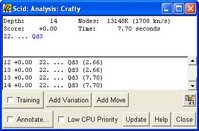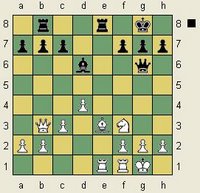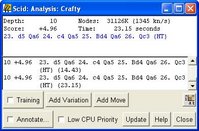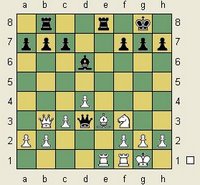Monday, January 29, 2007
Sunday, January 28, 2007
2007 Kindergarten Open
er... Cardinal Open rather. I played in it this weekend in the under 14 y/o section. er... under 1400 section rather. Boy there sure were a lot of kids there. I scored 4/5 and I am not sure if I won anything yet tied for second. I believe I won about $100 which means I played for free.
Here is the summary. I'll try to post the details later.
phorku Halasz Gambit Sicilian var - Sicilian 0-1
My first game was against a 10 y/o who was rated about the same as me. Due to losing the first round all my other oppenents were much weaker. Since I am not playing for money I will never play at the top of a section again, I will play up.
phorku Halasz Gambit Sicilian var - Sicilian 0-1
- I lost due to a mental abberation. 11 Qe1 was my first choice move. I decided e2 was a better home. I make my sanity check and play Qe1. Duh! Then I make a horrible move next and end up with a choice between ugly, uglier and ugliest. Jettison the Bishop for a possible mating attack, Trade queens and hope I have enough left for a mating attack - he is going to castle out of it, or trade queens to a hopelessly lost endgame.
- an uninteresting game where my opponent played for a mate in 1 when I had mate in 3 on the board
- I learn that I need to play harder when I am ahead. I was careful but totally missed my opponents chance to equalize. (No Crafty it is not 22 ... Qd3) Luckily my opponent had the complimenting disorder of getting frustrated when behind and missed his opportunity.
- There is an interesting feature in this game. I call it artifacting. I screwed around going for simple mates instead of trading down right away. My opponent traded down for me and left me with an isolated pawn which would normally be weak. Look at the role it plays later in the game controlling vital center squares with the Bishop while the King mops up and protects the promotion square.
- A trial of my modified opening against a much weaker player.
- Fun game.
- Got way too cocky.
- Start understanding how to take advantage of color complexes instead of being taken advantage by them.
- A seemingly innocent patzer move (no this is not the stonewall that square is verboten) then a horrible move totally destroys my opponents position.
- A fun game.
- I penetrate his position like.... never mind.
- I pass up calculating several mating attacks (or miscalculating as the case may be) and win material / simplify.
- Opponent totally blew all my plans by castling long and had to get my head around a new game.
- A subtle move tears open his postion.
- Free Rook Lift. Thanks buddy. Crafty you don't have any sense sometimes, though you still humble me.
My first game was against a 10 y/o who was rated about the same as me. Due to losing the first round all my other oppenents were much weaker. Since I am not playing for money I will never play at the top of a section again, I will play up.
Tuesday, January 23, 2007
3555 Problems Completed
I have passed the 2000 mark on CTS.
Since September 8th, 2005 I have completed over 3,555 problems:
CT-Art Level 10 x 3 + 96 89% / 85% / 93% / 90%
CT-Art Level 20 x 2 76% / 78%
CT-Art Level 30 x 2 57% / 62%
CT-Art Level 40 x 1 56%
CTS 2007 / 77.3% / rating: 1335
Since September 8th, 2005 I have completed over 3,555 problems:
CT-Art Level 10 x 3 + 96 89% / 85% / 93% / 90%
CT-Art Level 20 x 2 76% / 78%
CT-Art Level 30 x 2 57% / 62%
CT-Art Level 40 x 1 56%
CTS 2007 / 77.3% / rating: 1335
"T.H.I.E.F.S."
A couple posts back I mentioned I had been trying to come up with an acronym(s) to aid in my thought process. I stumbled accross this page:
The Art And Craft of Planning in Chess
The Art And Craft of Planning in Chess
Dutch Defense with b6 Bb7
 I have been messing around with the Dutch but have found 2 things I really dont like. Here is the typical dutch set up (I never play g6 and try at all costs to avoid the stonewall with its weak square).
I have been messing around with the Dutch but have found 2 things I really dont like. Here is the typical dutch set up (I never play g6 and try at all costs to avoid the stonewall with its weak square).1. Queen side pieces are bottled up.
2. e6 pawn is weak.
 Here is the structure I have been experimenting with. Sometimes I still play d6.
Here is the structure I have been experimenting with. Sometimes I still play d6. Does anyone have any information on this type of Dutch / Dutch Indian?
I found these 2 pages but little else.
Jacques Meises Dutch defence 1. d4 f5 2. g3 b6
Nimzo-Indian_Defence (check out Dutch Variation)
Monday, January 15, 2007
Over Protection Correction
Mark Weeks from Belgium sent me this nice comment.
Just a note that your definition of over-protection ('denying your opponent tactical opportunities'), a Nimzovich term, is more like a definition of prophylaxis, another Nimzovich term. Over-protection is aiming your pieces at one of your own strong points, like a center square, and hoping that the combined action of those pieces will result in new opportunities. As you rightly point out, the idea behind prophylaxis is important, but the idea behind over-protection is something of a backwater.
It's also worth mentioning that 'denying your opponent tactical opportunities' could be stated 'denying your opponent *any* opportunities'. Many strong players -- Petrosian and Karpov come to mind -- were also expert at squelching both tactical *and* positional counterplay. - Mark
Just a note that your definition of over-protection ('denying your opponent tactical opportunities'), a Nimzovich term, is more like a definition of prophylaxis, another Nimzovich term. Over-protection is aiming your pieces at one of your own strong points, like a center square, and hoping that the combined action of those pieces will result in new opportunities. As you rightly point out, the idea behind prophylaxis is important, but the idea behind over-protection is something of a backwater.
It's also worth mentioning that 'denying your opponent tactical opportunities' could be stated 'denying your opponent *any* opportunities'. Many strong players -- Petrosian and Karpov come to mind -- were also expert at squelching both tactical *and* positional counterplay. - Mark
Friday, January 12, 2007
Interesting game
Here is the game(new window) I was talking about in my previous post. I use a variety of tools to accomplish my goal.
- Played the player and the board
- Aggressive opening
- Control dark squares
- Gain space advantage
- Gain pawn through tactics
- Keep opponents dark bishop bad through much of the game
- Trade down to endgame with space and pawn advantage
- Advance Kingside pawns after Queen's are off the board
- Centralize King for endgame
- Maintain initiative through much of the game
Wednesday, January 10, 2007
Repitition not required for pattern recognition...
I have been reading Pandolfini's end game course and he has a positon similar to the one below except the queen is a rook. I was down to my last couple seconds in a time delay game. White has a number of options but I recognized the example instantly and moved Ke6 ;-) My opponent pushed his pawn and hit the clock. Can you see the next couple of moves?

Btw what is supposed to be the sequence for promoting a pawn at the club? Everyone pushes their pawn and hits the clock and both players usually scamble for the Queen. Can anyone tell me?
Anyway in this game he pushed hit the clock then I made my next move and hit the clock. He wanted his Queen and I told him it didn't matter. He saw instantly I was right and we played through to mate.
It was a very tough and interesting game. If I have time I will post the annotated portion later.

Btw what is supposed to be the sequence for promoting a pawn at the club? Everyone pushes their pawn and hits the clock and both players usually scamble for the Queen. Can anyone tell me?
Anyway in this game he pushed hit the clock then I made my next move and hit the clock. He wanted his Queen and I told him it didn't matter. He saw instantly I was right and we played through to mate.
It was a very tough and interesting game. If I have time I will post the annotated portion later.
Sunday, January 07, 2007
Past problem rears it's ugly head again
Last year at the club I got really frustrated because I could not beat players in a G30 game that I could clearly outplay. I could get a winning position but would run out of time. If only I could think faster was all I could say. I solved that temporarily by playing a lot of 5 12 blitz and positional study helped me make decent moves quickly in non-tactical postitions. Tactical study and pattern recognition has definately played a part as well.
Now I am having a similar problem. I can play into a position where I have a lot of pressure on my opponent and it looks like I have an overwhelming attack but I cannot calculate to checkmate, advantage or quiet postion. So now I am trying to come up with some guidelines where a sacrifice or all out attack would be in my favor. Obviously there is no substitution for calcluation but I am lucky if I can 3 or 4 moves deep in a complicated postition.
So 'The art of Sacrifice' is sounding very interesting to me right now. Too bad I don't have it. Anyway I am trying to come up with some guidelines for when to start my attack when calculation fails.
I have a few to try out.
I am reading 'The Tao of Chess' right now. I think the book sucks as far as some of the examples they give. But it is good for me to come up with new ideas.
One idea I got from the book is a Queen and a Rook is enough to mate a King in the open. The examply sucked in the book and what exactly is 'in the open' and how many defender can be around? Ovioulsy these questions can not be answered easily. At lest the example does give some clue.
So this is how I will apply it. If I can trade down my attack to where I have a R and Q left with my opponent having 1 or less pawns left and 1 or less pieces to defend with then I will pursue my attack.
What I have come up with on my own is to count the number of pieces I have in the attack and the number of pieces he has in defense. If it is 1 greater then I should consider the next step of how many pieces can I easily bring into the attack and and how many piece can he easily bring to defense. And finally do either of us have any inactive pieces and then if things look favorable start an attack.
I am already very comfortable making a B sac on h6/3 (it makes me salivate when they put a little ear on their castled K) with the QB battery if I have some other piece to support bring into play etc. I have also learned the valuable lesson of leaving the the Q on h6/3 where King is one check away from mate. In the past I have foolishly moved my q to give check on the g file and allow his R to come into play. Sometimes that has been quite disasterous.
I would appreciate any other guidlines you guys use when deciding to attack.
Now I am having a similar problem. I can play into a position where I have a lot of pressure on my opponent and it looks like I have an overwhelming attack but I cannot calculate to checkmate, advantage or quiet postion. So now I am trying to come up with some guidelines where a sacrifice or all out attack would be in my favor. Obviously there is no substitution for calcluation but I am lucky if I can 3 or 4 moves deep in a complicated postition.
So 'The art of Sacrifice' is sounding very interesting to me right now. Too bad I don't have it. Anyway I am trying to come up with some guidelines for when to start my attack when calculation fails.
I have a few to try out.
I am reading 'The Tao of Chess' right now. I think the book sucks as far as some of the examples they give. But it is good for me to come up with new ideas.
One idea I got from the book is a Queen and a Rook is enough to mate a King in the open. The examply sucked in the book and what exactly is 'in the open' and how many defender can be around? Ovioulsy these questions can not be answered easily. At lest the example does give some clue.
So this is how I will apply it. If I can trade down my attack to where I have a R and Q left with my opponent having 1 or less pawns left and 1 or less pieces to defend with then I will pursue my attack.
What I have come up with on my own is to count the number of pieces I have in the attack and the number of pieces he has in defense. If it is 1 greater then I should consider the next step of how many pieces can I easily bring into the attack and and how many piece can he easily bring to defense. And finally do either of us have any inactive pieces and then if things look favorable start an attack.
I am already very comfortable making a B sac on h6/3 (it makes me salivate when they put a little ear on their castled K) with the QB battery if I have some other piece to support bring into play etc. I have also learned the valuable lesson of leaving the the Q on h6/3 where King is one check away from mate. In the past I have foolishly moved my q to give check on the g file and allow his R to come into play. Sometimes that has been quite disasterous.
I would appreciate any other guidlines you guys use when deciding to attack.
Tuesday, January 02, 2007
Club Update
I won 2 of 3 at the club on two Tuesday's ago and piced up another 40 points. Thats like 227 points in 34 days. I was the lowest rated player at the club due to the low attendance (and my class d rating). I think my rating is probably going to level off a bit now. I am having the same problems against the stronger players that I was having against the weaker players last year in these G30 games. I have to use a lot of my time to get into a winning position but often don't have enough time left to win. I have played a lot of 5 12 blitz over my break from the chess club to train myself to move faster / think faster. The 5 12 games are about half the time of our G30 games. Postitional training has helped alot too. I used to be stuck in quiet or closed positions trying to come up with good moves or a plan. No that I am not just looking for tactics the basic positional stuff really helps out. I also won 2 games due to pattern recognition. One was due to some endgame patterns and the other was due to a mating pattern. I was so short on time in these games that I would have lost if I had to figure it out at the board. That is one big advantage to blitz games. You can play more of them. Some experience is just do to repition. Correspondence play really helped with my endgame studies. Many of my correspondence games went to the end game and I learned many of the basics by studying the postions. The most valueable lesson I learned from the was oppositon and combining that with pawn moves to prevent the enemy king (or other pieces from penetrating my postion).
I got 1 win out of 3 at the club last week playing against one player rated about the same as me and 2 that were higher. This week I won one sloppy game against a lower rated player. Had a won game against another lower rated player and blundered on time. I lost the 3rd game because of touch move. I was looking at (B)d3 and reached down and grabbed my king by accident. I did not pick it up and there is not a player at the club that would make such a retarded move. I looked my oppenent in the eye and he says "touch move". Well I have a new goal now. Now I don't care about my rating as much as the chance to play him again.
I got 1 win out of 3 at the club last week playing against one player rated about the same as me and 2 that were higher. This week I won one sloppy game against a lower rated player. Had a won game against another lower rated player and blundered on time. I lost the 3rd game because of touch move. I was looking at (B)d3 and reached down and grabbed my king by accident. I did not pick it up and there is not a player at the club that would make such a retarded move. I looked my oppenent in the eye and he says "touch move". Well I have a new goal now. Now I don't care about my rating as much as the chance to play him again.





